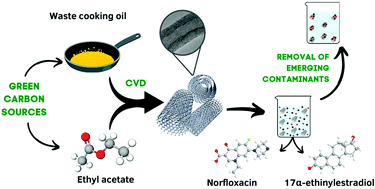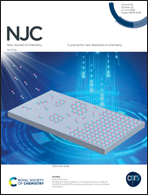Carbon nanotubes derived from waste cooking oil for the removal of emerging contaminants†
Abstract
It is already well known that water is critical to our existence yet increased anthropogenic activities have raised global concerns about the quality of water resources available to the population. These concerns are further exacerbated by emerging contaminants, commonly found in water, with largely unknown long-term health effects. As such, there exists an urgent need for the development of novel, sustainable and efficient adsorbents for the removal of these contaminants. While such materials already exist, they often require expensive and relatively toxic precursors, inhibiting their large-scale application. Herein, we report two synthetic routes to produce carbon nanotubes, for the removal of emerging contaminants from water, using green carbon sources namely ethyl acetate and waste cooking oil. We extensively investigated their morphological and physicochemical properties and studied the adsorption of two model molecules, the antibiotic norfloxacin and the hormone 17α-ethinylestradiol. TEM showed that both carbon sources employed and the supported catalyst (Fe–Mo/MgO) used were effective in multi-walled carbon nanotube (MWCNT) formation, presenting morphologies of bamboo-like and chain-like types. We determined that the adsorption capacity ranged from 24.5 mg g−1 to 48.9 mg g−1 for both materials. These results indicate their good adsorptive capacity for the contaminants compared to CNTs synthesized using conventional precursors. Moreover, we conducted kinetic studies, which pointed to the pseudo-second-order behavior of all systems. These promising results open novel avenues for replacing conventional adsorbent materials with more sustainable and efficient carbon materials for the adsorption of emerging contaminants in water.



 Please wait while we load your content...
Please wait while we load your content...